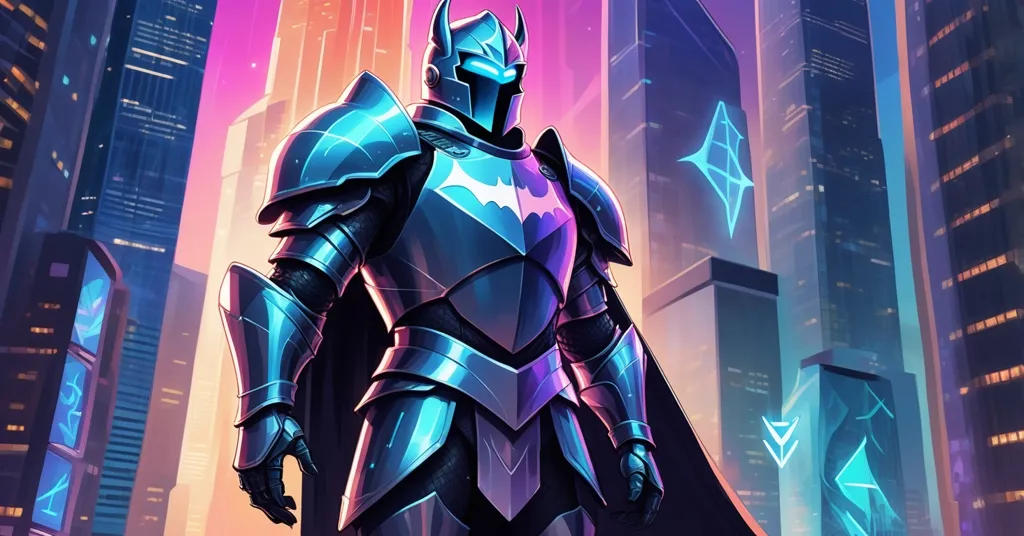BAT Price Prediction 2025-2031: Can Basic Attention Token Disrupt Digital Ads?

BAT Price Prediction 2025-2031: Is Basic Attention Token a Smart Investment?
Basic Attention Token (BAT) stands out in the crowded altcoin arena by powering a privacy-first digital advertising model through the Brave Browser. With speculative price forecasts buzzing for 2025 to 2031, the big question looms: can BAT deliver real value, or is it just another overhyped utility token destined to fizzle? Let’s dissect the potential and pitfalls of this blockchain disruptor.
- Price Outlook: Forecasts suggest BAT could climb from a high of $0.22 in 2025 to $1.69 by 2031.
- Market Mood: BAT’s price is idling, with no clear direction as investors sit on the fence.
- Web3 Push: Brave’s ‘.brave’ on-chain domain marks a bold step toward a decentralized internet.
Brave Browser’s Mission: A Middle Finger to Big Tech Ads
At its core, BAT is the fuel for a revolutionary idea: upending the $600 billion digital advertising industry, which is currently dominated by centralized giants like Google and Meta. These behemoths hoard user data and rake in profits while users get nothing but targeted ads and privacy invasions. Enter Brave Browser, a privacy-focused alternative with over 85 million monthly active users. Brave blocks trackers by default and lets users opt into viewing ads in exchange for BAT rewards. Content creators—1.5 million verified ones so far—also get paid directly in BAT, bypassing middlemen. It’s a direct challenge to the status quo, embodying the decentralization and user empowerment we champion.
For those new to the space, BAT is a utility token initially built on Ethereum, the second-largest blockchain known for smart contracts (self-executing agreements on the blockchain). It’s also bridged to Solana, a faster, low-cost blockchain, as an SPL token—a standard that lets BAT play in Solana’s ecosystem. This opens doors beyond ads into decentralized finance (DeFi), where users can trade, lend, or earn interest on crypto assets. But while the concept is slick, the real test is whether Brave can scale to challenge Chrome’s 65% market share. Eighty-five million users sound impressive, but it’s a speck against billions. Can BAT’s model genuinely disrupt, or is it a noble experiment doomed to niche status?
Price Predictions: Dreamy Forecasts or Dartboard Guesses?
Now, let’s tackle the juicy bit—price speculation. Analysts from various sources project a gradual ascent for BAT over the next decade. By 2025, they see a range of $0.09 to $0.22, averaging $0.16. Come 2027, it’s expected to hover between $0.34 and $0.40, with a midpoint of $0.35. The numbers get spicier by 2030, with an average of $1.00 in a range of $0.96 to $1.16. The peak prediction hits in 2031, with a high of $1.69, a low of $1.37, and an average of $1.40. Sounds like a hodler’s dream, right? Not so fast. These forecasts, much like those found in detailed BAT price predictions for 2025-2031, are often just educated guesses, akin to predicting lottery numbers—fun to fantasize about, but don’t quit your day job over them.
BAT’s price history paints a volatile picture. Launched in a 2017 ICO at $0.04, it raised $35 million in under 30 seconds, hyped as the future of ads. Its first logged price on CoinMarketCap was $0.17 in June 2017. The token skyrocketed to an all-time high of $1.92 on November 28, 2021, during the last major bull run, but crashed to an all-time low of $0.006621 in July 2017. Recently, it dipped to $0.1653 in July 2024 before hitting a modest high of $0.3532 in Q4 2024. Currently, BAT’s price is sleepwalking through the market, stuck in neutral territory. Technical indicators like the Relative Strength Index (RSI)—a measure of whether an asset is overbought or oversold—sit at 52.71 on the daily chart and 56.33 on the 4-hour chart, signaling pure indecision. It’s like a car idling at a stoplight, unsure whether to gun it or slam the brakes.
Here’s the harsh truth: long-term price predictions in crypto are often bullshit. They’re based on past trends and market sentiment, not hard data like Brave’s ad revenue or user retention. A single market crash, regulatory gut punch, or failure to scale could torch these numbers overnight. We’ve seen too many “experts” shill moonshots only for tokens to crash into oblivion. So, take these forecasts with a truckload of salt—BAT’s value hinges on real-world adoption, not crystal ball prophecies, as echoed in various price prediction analyses for BAT.
Web3 Innovation: ‘.brave’ Domain and the Decentralized Internet
Beyond price charts, Brave is making waves with tangible moves. Their recent partnership with Unstoppable Domains to launch the ‘.brave’ on-chain domain is a first for any browser. This collaboration with Unstoppable Domains lets users replace clunky, 40-character crypto wallet addresses with readable names like “john.brave.” With over 4.2 million domains registered via Unstoppable Domains, this isn’t just a gimmick—it’s a push for digital identity control, putting power back in users’ hands instead of platforms’. Sandy Carter, COO of Unstoppable Domains, summed it up perfectly:
“This is a bold leap toward an open internet. ‘.brave’ puts digital identity in the hands of everyday users, not platforms.”
Brave is even exploring ICANN accreditation to make ‘.brave’ a generic top-level domain (gTLD), bridging the old internet with Web3. It’s a middle finger to centralized internet governance, aligning with our fight for freedom and privacy, as seen in their push for Web3 domain integration. But let’s not pop the champagne yet. Regulatory bodies like ICANN could slap this down with bureaucratic red tape, and global laws around internet domains remain a minefield. Plus, will users care enough to adopt Web3 names, or is this a solution looking for a problem?
BAT Beyond Ads: A DeFi Dark Horse?
BAT isn’t just a one-trick pony tied to advertising. Its integration with Solana as an SPL token opens up a playground in DeFi—decentralized finance, a sector where users can trade, lend, or earn rewards without banks. On Solana, known for lightning-fast transactions and dirt-cheap fees, BAT can be swapped on decentralized exchanges (DEXs) like Raydium or staked in liquidity pools (where users provide assets to facilitate trading and earn fees). This adds utility beyond Brave’s ad model, potentially attracting DeFi degens looking for yield (passive income from crypto holdings).
Yet, here’s the rub: DeFi is a wild west, riddled with hacks, scams, and rug pulls. BAT’s niche status also means it’s unlikely to draw the institutional money flooding into Bitcoin and Ethereum via ETFs and yield-bearing products. While altcoins like BAT can fill gaps Bitcoin doesn’t—think microtransactions or specific use cases—they’re often speculative side bets in a market where BTC remains digital gold, as discussed in broader market trend analyses. Can BAT carve out a DeFi foothold, or will it drown in a sea of flashier tokens?
Competitive Challenges: David vs. Corporate Goliaths
BAT’s biggest hurdle isn’t tech—it’s competition. The digital ad space is a heavyweight arena, with Google and Meta holding an iron grip thanks to sheer scale and user habits. Chrome alone commands over 65% of the browser market, while Brave is a blip by comparison. Then there are other blockchain ad players like AdEx Network, which also pushes transparency and decentralization. What sets BAT apart is Brave’s user base and privacy focus, but convenience often trumps ideals. Will users ditch Chrome for BAT rewards, or are we overestimating the hunger for privacy, as debated in community discussions on privacy concerns with Brave?
Moreover, BAT’s value is tethered to Brave’s growth. While 1.5 million verified creators accept BAT, mainstream adoption is nowhere near the level needed to justify lofty price targets. If Brave can’t scale—or worse, if privacy laws like the EU’s GDPR morph to restrict alternative ad models—BAT could stall. It’s a classic David-versus-Goliath tale, and David’s slingshot better be damn accurate.
Regulatory Risks: A Potential Gut Punch to Decentralization
Speaking of laws, regulatory uncertainty looms large. Privacy-focused tech like Brave often draws scrutiny from governments obsessed with control. Stringent rules around ad tracking or data protection could kneecap Brave’s model, directly hitting BAT’s utility. Then there’s the ‘.brave’ domain push—ICANN accreditation sounds great, but internet governance bodies might resist Web3 domains, viewing them as threats to centralized oversight. Add in broader crypto crackdowns, and BAT faces a gauntlet of risks that could crush its prospects faster than a meme coin rug pull. This isn’t just business risk; it’s a potential blow to the decentralized dream we’re fighting for.
Bitcoin Maximalism vs. Altcoin Niches: Where Does BAT Fit?
As much as we cheer for underdogs disrupting the status quo, a Bitcoin maximalist lens can’t be ignored. BTC is the king—digital gold, a store of value, and the safe harbor for institutional billions. Recent moves like Abu Dhabi’s $436.9 million Bitcoin ETF investment show where the big money flows. Altcoins like BAT, while innovative, often pale in comparison. BAT’s niche in advertising and DeFi is a strength, filling gaps Bitcoin shouldn’t or can’t address. But in a volatile market, it’s a speculative punt, not a bedrock asset. If you’re stacking sats (Bitcoin), is BAT worth a detour, or just a distraction, as pondered in investment discussions on whether BAT is a good investment?
Key Takeaways and Questions to Chew On
- What’s the projected price range for BAT from 2025 to 2031?
Forecasts suggest a rise from $0.22 high in 2025 to an average of $1.00 by 2030, peaking at $1.69 by 2031, though these are speculative and depend on market trends and Brave’s success. - Does Brave Browser’s growth make BAT a solid bet?
With 85 million users and 1.5 million creators on board, there’s momentum, but it’s a long shot against centralized ad giants, making BAT a high-risk, high-reward play. - How does the ‘.brave’ domain affect BAT’s potential?
It boosts Brave’s Web3 creds and could drive user engagement, indirectly supporting BAT, though it’s not a direct price driver and faces regulatory hurdles. - What are the biggest threats to BAT’s future?
Market crashes, regulatory clampdowns on privacy tech or Web3 domains, and failure to scale against ad titans could derail BAT’s trajectory in a heartbeat. - Can BAT hold its own in a Bitcoin-dominated crypto space?
Its unique use case in ads and DeFi sets it apart, but with institutional focus on BTC and ETH, BAT must prove its niche matters to stay relevant.
BAT embodies the gutsy, disruptive spirit we love in crypto—challenging Big Tech with a privacy-first, user-centric vision. But guts don’t guarantee glory in this brutal arena. The road ahead is littered with landmines: competition, regulation, and the sheer challenge of mass adoption. Price predictions are tempting, but they’re often just hype dressed as analysis. If you’re eyeing BAT, dig deep, ignore the shills, and remember that even the most promising altcoins can flatline. For now



